Croton - what is this plant and how to grow it?
Lovers of ornamental plants can surprise with the presence of an interesting plant in their collection - croton or in another way called Codiaum. Its peculiarity is that the shrub has foliage of various colors.
In addition to the specific coloration, the green pet is endowed with favorable electrical properties. But at the same time, you need to try to grow a healthy shrub with a flowering look. Therefore, before purchasing or starting to grow a plant, you should familiarize yourself with the growing conditions and the specific whims of an exotic pet.
Content:
- Features of the structure of a houseplant
- Growing conditions
- Reproduction and planting of croton
- How to properly care for him?
- Transplant terms and rules
- Diseases and pests, the fight against them
Features of the structure of a houseplant
Croton is a kind of exotic plants, inside the stems and leaves of which milky sap flows. Therefore, the shrub belongs to the euphorbia family. This specificity of the structure of the shrub allows you to quickly and painlessly tighten all the damage acquired by the flower in the shortest possible time. Due to the protruding juice, a small film appears on the damaged surface, which prevents any pathogenic bacteria from entering the plant.
But not looking at the ability of the juice to regenerate the surface of the trunk that was affected, the plant belongs to poisonous shrubs.
The liquid inside the stem contains a large amount of toxic substances that adversely affect when it comes into contact with the human skin. Such qualities of the flower were used in ancient states. The collected milky juice was used in the fight against warts, calluses, as a cauterization of the wound when bitten by animals prone to rabies.
If the milky juice, when not carefully collecting the bush, gets on the skin, it immediately causes a strong burning sensation and can provoke a burn. Upon contact with the mucous membrane of the organs of vision, it stimulates short-term blindness. Therefore, it is not recommended to walk pets near such plants. If a pet accidentally breaks a leaf or stem, the bush will release a toxic liquid before the pet moves away from the bush.
The first appearance of the plant is recorded in India, Southeast Asia and Australia. Under natural conditions, the shrub is capable of stretching up to 3 meters in height. Breeders have more than 1200 different varieties of croton.
Characteristic features of the plant:
- Differences in species in a certain shape of the leaf blade: notched, broadly ovate, pointed, three-lobed, asymmetric. Shrubs also boast all kinds of flowers.
- Young growth that has not yet matured to an adult state is distinguished by leafy plates of a light shade, yellow-green colors. As they grow older, foliage gradually turns into brighter, more saturated shades.Therefore, shrubs in their prime often acquire the appearance of autumn variegated trees, which have inflorescences of different colors: crimson, yellow, green.
- The leaves have a leathery surface and small petioles that attach to the central trunk.
- Croton inflorescences are faded, expressionless. Its small white flowers are collected in bunches in the form of small brushes. When flowering, they look somewhat poor, especially with the original color color.
- In indoor growing conditions, they almost never bloom. If the buds are tied, then in most cases it is better to remove this. This is due to the fact that the flower begins to pull on itself the nutritional properties that are required for the bright color of the leaf plates, which leads to their faded tone.
Most often, such types of flowers as Motley, Disraeli, Petra, Black Prince, Excellent, Mrs. Aiston, Variegatum grow at home.
Growing conditions
For normal growth and full development of croton, it is necessary to be guided by certain conditions for growing a shrub. To do this, you need to choose the optimal location for the plant:
- The sunny side is best for Croton. The brightness of the color of the leaf plates depends on the amount of sunlight absorbed by the foliage. The shrub is not afraid of the bright rays of the luminary, therefore, the most favorable conditions for keeping the bush on the west or east window, while diffused light is not required. After purchasing, it is worth carefully monitoring the shrub, due to the fact that he must get used to his new place of residence. Therefore, in a number of situations, it can fade, change color to a neutral green tone, or lose greens. If the croton liked the place, then it acquires the original foliage shade. In winter, the sun's rays are not at all scary for croton, so it is recommended to install it on the southern sides. If the sun is not enough, the shrub will only acquire green tones, having lost their original colors. If the daylight hours are reduced due to rain or gloomy sun, then it is better to illuminate the bush under phytolamps.
- The temperature regime for the shrub must be maintained in optimal conditions. Croton does not withstand heat, but is quite susceptible to moderate heat. In summer, +20 .. + 24C is a favorable temperature. If the thermometer shows +30 C, then the bush needs to be shaded and sprayed on the leaf plates. In winter, it is not recommended to lower the indicator on the thermometer below +16 C. A favorable temperature in the winter months will be +18 .. + 20 C. During sudden changes in temperature, Croton can get sick and die.
- Humidity for croton is of paramount importance. The shrub is a resident of tropical forests, therefore, requires high humidity. The optimal indicator is 45%. When this level decreases, you can find problems with the plant. In the summer, to maintain this condition, it is worth periodically spraying the flower or placing the flowerpot in a basin of filled water. In the autumn and winter months, spraying is also carried out, but with warm water and not so often. The frequency of irrigation of a flower from a spray bottle increases only during the period when the heating devices are turned on. Care must be taken to ensure that the air does not dry out.
Croton grows well in open or closed florariums. You can find varieties that have miniature sizes and leaf plates.
Reproduction and planting of croton
The flower propagates in several ways. To choose the best way to get the original plant, you should deal with all the options:
- Seeds - Croton is a dioecious plant that requires two varieties for reproduction - male and female. Moreover, there should be several female species.This is due to the fact that the shrubs all bloom at different periods, so it is important that at least one pair is matched for cross-pollination. In most cases, seed growing is used by breeders and experienced gardeners who want to get a new hybrid of a plant. But if seeds have been purchased, it is necessary to check that the date of their collection is recent. This is necessary due to the fact that the planting of seedlings is carried out immediately after collection, otherwise germination will be completely absent or will be minimal. Before planting, the seeds are soaked in potassium permanganate solution... After that, they are left in warm water for 1 day to swell. Planting is carried out in a soil mixture, where peat and river sand are combined. The deepening is not carried out deeply, only by 1 cm, or the seeds are laid out in the right order and sprinkled with soil in the amount of 1 cm. It should be controlled that the soil is always moist. Therefore, to create favorable conditions, it is recommended to cover the planting with a film. After the appearance of two real leaves on the sprout, the seedlings dive in separate pots for further independent living.
- Cuttings - the easiest and easiest way to get an original plant. Cutting and rooting cuttings is allowed throughout the year. But the most appropriate time is the moment from the last days of February and throughout April. For cuttings, small upper processes are used, which can be obtained during the formation of the crown of the flower. Do not forget about the poisonous qualities of the plant. Milky juice, protruding to the surface, can provoke edema. Therefore, it is worth doing planting work with rubber gloves. The cut must be washed with water, rinsed off the liquid and treated with crushed charcoal. Additionally, some growers use a growth enhancer. To plant a stalk, you need to prepare the soil: from peat and river sand of a coarse fraction. The temperature in the room should be at +24 C. The first roots appear within 1-1.5 months. During this period, it is recommended to spray the plantings with warm, settled water. After the appearance of the root system, it is required to transplant each process to a new place of residence.
- Layers - Many varieties can be propagated using air layering. To do this, a 1 cm incision is made on the surface of the branch along the entire perimeter of the stem. Apply to an open wound sphagnum moss... The resulting structure is wrapped in a film and firmly fixed from below and from above. Within 30 days, small roots appear inside. After that, the branch is cut below the rhizomes and transplanted to a permanent place of residence.
To find out exactly which method is more suitable for obtaining the original copy, you need to try all breeding methods and find the best option for yourself.
How to properly care for him?
In most cases, croton is an unpretentious plant, but if you periodically overlook caring for it, then the flower can be lost. The following features of caring for an exotic shrub are distinguished:
- Watering - carries out not only the introduction of nutrients, but also spraying from a spray bottle no more than 1 time per week. In the spring months, during the growing season, as well as in autumn, it is worth paying more attention to watering and irrigating the flower daily or every other day. It is imperative to ensure that the soil dries out a little between waterings and does not turn into a swampy substance.
- Top dressing - requires complex fertilizers throughout the entire calendar year. In autumn and spring months, top dressing should be applied once a week. In winter, the number of procedures is reduced to 1 time per month. Fertilizers should be purchased at a specialty store, but sometimes you can also add coffee grounds, banana peels or tea leaves.
- Pruning - carried out in most cases only to form the crown.I pick the last one in the form of a ball. Most often, pinching of the tops of the shoots is carried out so that the shrub forms lateral level shoots. The fresh cut is processed with ash or activated carbon. The first pruning is carried out as the plant grows and reaches 15-17 cm in height. The next event is carried out at the moment when the flower reaches 40 cm.In addition, as necessary, branches are removed that have been beaten by pests, diseases, have been mechanically damaged or withered.
When flowers appear, they need to be cut off. This is necessary due to the fact that the inflorescences take a lot of energy from the shrub. Therefore, it is worth eliminating white and yellow buds so as not to provoke a loss of brightness of the leaf plates.
Transplant terms and rules
Transplantation for an adult plant is not often carried out - once every 3-4 years. The event is held only after root system completely entwined with an earthen lump and is already beginning to crawl out of the pot. It is customary to transfer large specimens from one flowerpot to a container of a larger format. In most cases, such plants are not transplanted, they only replace the top layer of the earth with more fertile soil. Young shrubs that have not reached 3 years of age must be transplanted annually. Best of all, the procedure is carried out at the beginning of the growing season - in February - March.
For rooting of the planting material, it is necessary to pick up a slightly acidic soil, it must pass moisture and air well, and also be drained.
For planting, a soil substrate is purchased in a specialized store and drainage is added to it. As the latter, you can use perlite, expanded clay, small sea pebbles. If possible, the soil is prepared independently: sheet soil in the volume of 2 parts is combined with coarse sand of the river type and sod land taken in 1 part.
A specific pot must be selected. It must be stable. A plastic pot is ideal for young plants, and a clay pot for large specimens. The new container should be just a few cm larger in diameter from the previous flowerpot. If we take a flowerpot much larger than the volume, then the growth of ground foliage should not be expected, the plant will not begin to grow until it completely braids the new territory with rhizomes.
It is worth adhering to the following landing rules:
- Croton should be transplanted without shaking off the soil from the plant.
- Drainage is laid out on the bottom, at least 3 cm.
- Transplanting is carried out using transshipment, while fresh soil is poured on the sides.
- After moving to a new container, the bush is watered and rearranged to a lighted place, but previously shaded.
Transplanting should only be done with healthy plants. After acquiring a new variety, you should not immediately carry out transshipment, the plant must acclimatize.
Diseases and pests, the fight against them
Failure to follow the rules of plant care leads to the appearance of pathogenic bacteria and pests on the leaf plates. There are the following problems that occur under improper growing conditions:
- Spider mite - forms a cluster of white cobwebs on the foliage. The appearance of the pest is due to the dry air in the room. To eliminate the parasite, the bush is washed with soapy water or irrigated with chemicals.
- Scabbard - its appearance is due to the appearance of dry plaques of a light brown hue on the leaf plates or stems. The fight is carried out using similar methods as with spider mites.
- Burns - triggered by bright sunlight. The plant must be rearranged from the south window to the west or east.
- The tips of the foliage become dry and turn black - what happens when there is insufficient humidity in the room. if the care is not corrected, then the croton will shed the foliage and die.
- Drops foliage - the room temperature is quite low (+10 .. + 12 C). An urgent need to move the shrub to a warm place.
- The color of croton fades - a lack of sunlight is revealed.
If you adhere to the basic rules for caring for a bush, then such problems will never affect the pet. It is recommended that when the first signs of malaise appear, urgently take pest control measures or look for the cause inside the flowerpot.
Thus, Croton has a unique bright color, which is difficult to replicate with another variety. In order for the plant to grow magnificently and often release new leaves, you need to take proper care and control the general condition. If any discomfort occurs, drastic measures should be taken immediately.
More information can be found in the video:



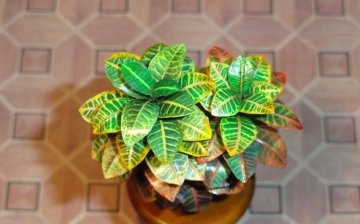


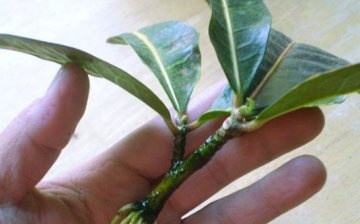
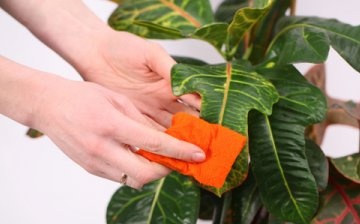
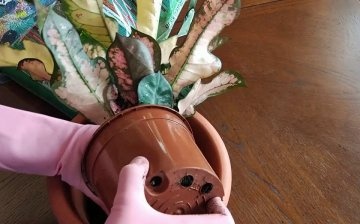
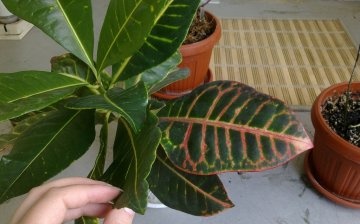







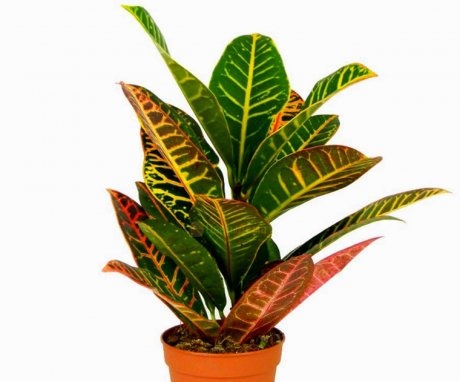
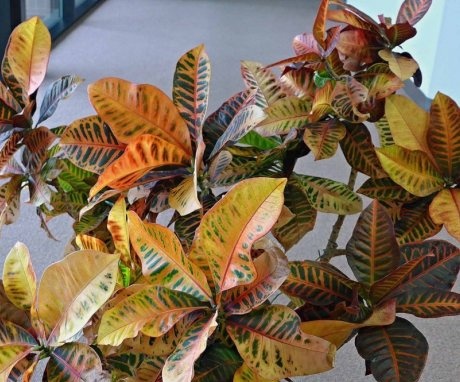
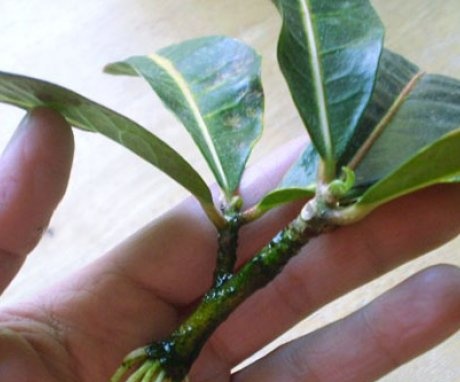
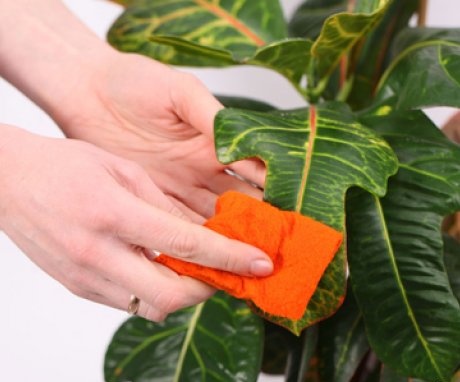
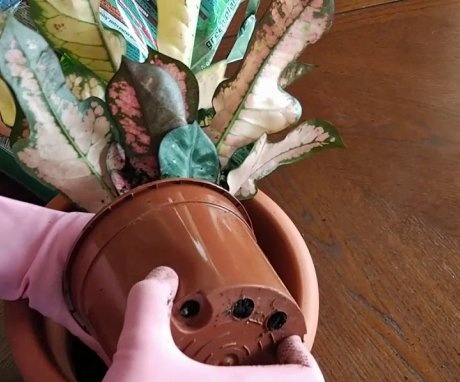
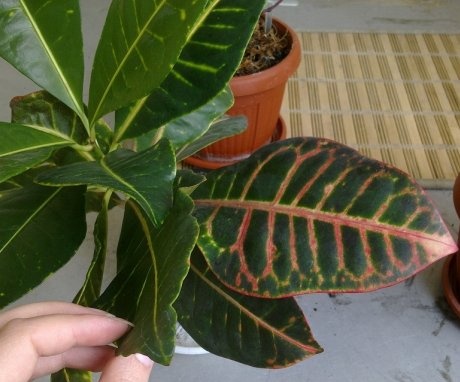
I had a croton. After the purchase, I immediately transplanted it into a large pot, so it was recommended. Grew up big, beautiful. But he did not live on the sunny side of my house and he liked it. He didn't like drafts. It is very important to water on time, otherwise the leaves will droop quickly along the stem.